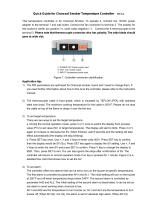
P
ARAMETER DESCRIPTIONS
S
P1=Setpoint of relay1. Variable between r4 and r6.
S
P2=Setpoint of relay 2. Variable between r5 and r7.
r
0=Dependency between SP1 and SP2. Only for mode ONOFF1
Ind=set point for relay 2, SP2.
dep=set point for relay 2, SP1+SP2.
r1=Differential or hysteresis for relay 1. Temperature differential between ON/OFF
o
f relay 1 in ON/OFF control.
r
2=Differential or hysteresis for relay 2. Temperature differential between ON/OFF
o
f relay 2 in ON/OFF control.
r
3=Band differential. Temperature differential between ON/OFF of relays 1 and 2 in
neutral area control. For relay 1 it is added to SP1 and for relay 2 it is subtracted
from SP1.
r4=Lowest value for SP1.
r
5=Lowest value for SP2.
r
6=Highest value for SP1.
r
7=Highest value for SP2.
r8=Regulation or operating mode. Selection of the operating mode.
A0=Alarm differential. It is the temperature differential between the alarm On and
Off cycle.
A1=Maximum alarm probe1.
M
aximum alarm ON when probe 1 higher than SP1+A2
M
aximum alarm OFF when probe 1 lower than SP1+A2-A0.
A
2=Maximum alarm probe2.
Maximum alarm ON when probe 2 higher than SP2+A2
Maximum alarm OFF when probe 2 lower than SP2+A2-A0.
A3=Minimum alarm probe1.
Minimum alarm ON when probe 1 lower than SP1-A3
M
inimum alarm OFF when probe 1 higher than SP1-A3+A0.
A
4=Minimum alarm probe2.
M
inimum alarm ON when probe 2 lower than SP2-A4
Minimum alarm OFF when probe 2 higher than SP2-A4+A0.
A5=Alarm verification time. Time from the alarm event until it trips.
A6=Alarm probe 1 selection. (See Figure 3).
AHL=Maximum and minimum alarm probe 1 enabled.
Ano=No alarms probe 1.
AH=Maximum alarm probe 1 enabled.
AL=Minimum alarm probe 1 enabled.
A7=Alarm probe 2 selection. (See Figure 3).
AHL=Maximum and minimum alarm probe 2 enabled.
Ano=No alarms probe 2.
AH=Maximum alarm probe 2 enabled.
AL=Minimum alarm probe 2 enabled.
c
0 = Minimum relay stop time. Minimum time from the disconnection of a relay until
i
t can be switched on again.
c1 = Operation relay 1. Selection between direct or reverse operation for relay 1.
c2 = Operation relay 2. Selection between direct or reverse operation for relay 2.
c3 = Default operation relay 1. In case of failure of probe 1:
o
Pn= relay 1 will remain open.
C
lo= relay 1 will remain closed.
c
4 = Default operation relay 2. In case of failure of probe 1 (for all modes except-
i
ng ON OFF2) or in case of failure of probe 2 (for mode ON OFF2):
oPn= relay 2 will remain open.
Clo= relay 2 will remain closed.
P0 = Temperature scale selection.
P
1 = Calibration of probe 1. Offset degrees to be added to probe 1.
P
2 = Calibration of probe 2. Offset degrees to be added to probe 2.
P
3 = Decimal point. If the displayed value of the probes is desired with decimals or
not.
P4 = Probe to be displayed. Probe always on the display. The other probe can be
seen pressing the keys SET+UP.
sd1= probe 1.
s
d2= probe 2.
P
5 = Number of probes. If P5=1, there is no ONOFF2 mode. If selected, it will oper-
a
te as ONOFF1.
H0 = Reprogramming. Parameter to reprogram the thermostat.
H1 = Keyboard protection.
To change the settings, enter into parameter and exit again. The protection setting
is momentarily released. It switches on again 1 minute after the last time a key was
p
ressed.
Y
es = Keyboard Protected.
N
o = Keyboard non protected.
H2 = Operation of LED OUT1.
dir = On when relay 1 is ON.
inv = On when relay 1 is OFF.
H3 = Operation of LED OUT2.
dir = On when relay 2 is ON.
inv = On when relay 2 is OFF.
H4 = Serial communication address. Address for computer connection.
H5 = Parameter entry code. Factory set as 0.
MAINTENANCE
After final installation of the TSW Series Digital Temperature Switch, no routine
maintenance is required. A periodic check of system calibration is recommended.
The devices are not field repairable and should be returned to the factory if recali-
bration or other service is required. After first obtaining a Returned Goods
Authorization (RGA) number, send the material, freight prepaid, to the following
address. Please include a clear description of the problem plus any application
information available.
Dwyer Instruments, Inc.
Attn: Repair Department
102 Highway 212
Michigan City, IN 46360 U.S.A.
Figure 3






